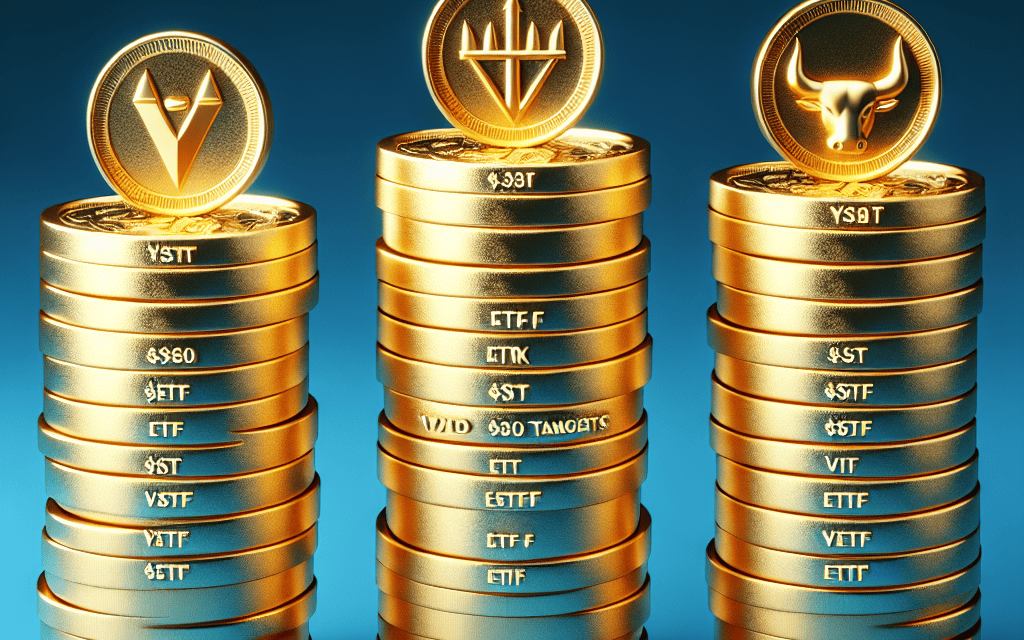“Vanguard ETFs: Your Trio for Timeless Income – VIG, VYM, BND.”
Introduction
Vanguard offers a range of Exchange-Traded Funds (ETFs) that are popular among investors seeking to generate lifetime passive income. Three notable options include:
1. **Vanguard Dividend Appreciation ETF (VIG)**: This ETF focuses on companies with a strong track record of increasing dividends over time. By investing in high-quality, dividend-growing companies, VIG aims to provide investors with a reliable income stream and potential for capital appreciation.
2. **Vanguard High Dividend Yield ETF (VYM)**: VYM targets companies with above-average dividend yields, offering investors exposure to a diversified portfolio of high-yielding stocks. This ETF is designed for those seeking higher current income while maintaining a broad exposure to the U.S. equity market.
3. **Vanguard Real Estate ETF (VNQ)**: VNQ provides exposure to real estate investment trusts (REITs), which are known for their income-generating potential. By investing in a wide array of real estate sectors, VNQ offers investors the opportunity to earn passive income through dividends derived from real estate holdings.
These ETFs are structured to provide investors with diversified exposure to income-generating assets, making them suitable options for those looking to build a portfolio focused on generating passive income over the long term.
Understanding Vanguard’s Dividend Growth ETF: A Path to Passive Income
Vanguard’s Dividend Growth ETF is a compelling option for investors seeking to generate lifetime passive income. This exchange-traded fund (ETF) is designed to provide exposure to a diversified portfolio of companies with a strong track record of increasing dividends over time. By focusing on dividend growth, investors can potentially benefit from both income and capital appreciation, making it an attractive choice for those looking to build a sustainable income stream.
One of the key advantages of the Vanguard Dividend Growth ETF is its emphasis on quality. The fund primarily invests in large-cap companies with a history of stable earnings and robust financial health. These companies are typically leaders in their respective industries, possessing competitive advantages that allow them to maintain and grow their dividend payments. As a result, investors can have confidence in the reliability of the income generated by this ETF.
Moreover, the Vanguard Dividend Growth ETF offers diversification across various sectors, which helps mitigate the risks associated with investing in individual stocks. By spreading investments across different industries, the fund reduces the impact of sector-specific downturns on the overall portfolio. This diversification is crucial for maintaining a steady income stream, as it ensures that the performance of the ETF is not overly reliant on any single sector.
In addition to diversification, the ETF’s low expense ratio is another appealing feature. Vanguard is renowned for its commitment to keeping costs low, and this ETF is no exception. With a lower expense ratio compared to many actively managed funds, investors can retain more of their returns, which is particularly important for those relying on dividends for income. Over time, these cost savings can significantly enhance the overall return on investment.
Furthermore, the Vanguard Dividend Growth ETF is structured to provide tax efficiency. ETFs, in general, are known for their tax advantages, and this fund is designed to minimize capital gains distributions. This feature is beneficial for investors who are looking to maximize their after-tax income, as it reduces the tax burden associated with frequent buying and selling of securities within the fund.
Transitioning to the broader market context, it is important to consider the role of dividend growth in an investment strategy. Historically, companies that consistently increase their dividends have outperformed those that do not. This trend underscores the potential for dividend growth stocks to deliver superior long-term returns. By investing in the Vanguard Dividend Growth ETF, investors can tap into this trend and benefit from the compounding effect of reinvested dividends.
Moreover, the focus on dividend growth aligns with the needs of retirees and those approaching retirement. As individuals transition from the accumulation phase to the distribution phase of their financial lives, the need for a reliable income stream becomes paramount. The Vanguard Dividend Growth ETF can serve as a cornerstone of a retirement portfolio, providing a steady flow of income that can help cover living expenses without depleting the principal investment.
In conclusion, the Vanguard Dividend Growth ETF offers a well-rounded approach to generating lifetime passive income. Its focus on quality, diversification, low costs, and tax efficiency makes it an attractive option for investors seeking a reliable income stream. By investing in this ETF, individuals can benefit from the growth potential of dividend-paying companies while enjoying the peace of mind that comes with a diversified and professionally managed portfolio.
How Vanguard’s High Dividend Yield ETF Can Boost Your Retirement Portfolio
Investing for retirement is a crucial aspect of financial planning, and selecting the right investment vehicles can significantly impact the sustainability of your income during your golden years. Among the myriad of options available, Vanguard’s High Dividend Yield ETF (VYM) stands out as a compelling choice for those seeking to enhance their retirement portfolios with a steady stream of passive income. This exchange-traded fund is designed to track the performance of the FTSE High Dividend Yield Index, which comprises companies known for their robust dividend payments. By focusing on high-quality, dividend-paying stocks, VYM offers investors the potential for both income generation and capital appreciation.
One of the primary advantages of incorporating VYM into a retirement portfolio is its focus on dividend yield. Dividends represent a portion of a company’s earnings distributed to shareholders, and they can serve as a reliable source of income, especially during periods of market volatility. VYM’s strategy of investing in companies with a history of paying dividends ensures that investors receive regular income, which can be particularly beneficial for retirees who rely on their investment portfolios to cover living expenses. Moreover, the reinvestment of dividends can lead to compounding returns over time, further enhancing the growth potential of the portfolio.
In addition to its income-generating capabilities, VYM offers diversification benefits that can help mitigate risk. The ETF holds a broad array of stocks across various sectors, including consumer goods, healthcare, and financials, among others. This diversification reduces the reliance on any single sector or company, thereby lowering the overall risk of the portfolio. Furthermore, VYM’s focus on large-cap, established companies with strong financials adds an additional layer of stability, as these firms are generally better equipped to weather economic downturns and continue paying dividends.
Another noteworthy aspect of VYM is its cost-effectiveness. Vanguard is renowned for its low-cost investment products, and VYM is no exception. With a competitive expense ratio, this ETF allows investors to retain more of their returns, which is crucial for long-term growth. Lower fees mean that a larger portion of the dividends and capital gains can be reinvested, compounding over time and contributing to the overall performance of the portfolio. This cost efficiency, combined with the fund’s focus on high dividend yields, makes VYM an attractive option for those looking to maximize their retirement income.
While VYM offers numerous benefits, it is essential for investors to consider their individual financial goals and risk tolerance before making investment decisions. Although dividend-paying stocks tend to be less volatile than growth stocks, they are not immune to market fluctuations. Therefore, it is advisable to maintain a well-balanced portfolio that includes a mix of asset classes to ensure a comprehensive approach to retirement planning.
In conclusion, Vanguard’s High Dividend Yield ETF presents a viable option for investors seeking to bolster their retirement portfolios with a reliable source of passive income. By focusing on high-quality, dividend-paying stocks, VYM provides the potential for both income generation and capital appreciation. Its diversification benefits, cost-effectiveness, and emphasis on stability make it a valuable addition to any retirement strategy. As with any investment decision, careful consideration and alignment with personal financial objectives are paramount to achieving long-term success.
The Role of Vanguard’s Total Stock Market ETF in Long-Term Income Generation
Vanguard’s Total Stock Market ETF (VTI) plays a pivotal role in the landscape of long-term income generation, offering investors a comprehensive approach to passive income. As a cornerstone of many investment portfolios, VTI provides exposure to the entire U.S. stock market, encompassing large-, mid-, and small-cap stocks. This broad diversification is crucial for mitigating risk and enhancing the potential for stable returns over time. By investing in VTI, individuals gain access to a wide array of companies across various sectors, which collectively contribute to a balanced and resilient income stream.
One of the primary advantages of VTI is its low expense ratio, a hallmark of Vanguard’s commitment to cost-effective investing. This low-cost structure ensures that a larger portion of the investor’s capital is working for them, rather than being eroded by fees. Over the long term, minimizing expenses can significantly enhance the compounding effect, thereby increasing the potential for generating substantial passive income. Furthermore, VTI’s structure as an ETF provides tax efficiency, as it typically incurs fewer capital gains distributions compared to mutual funds. This tax efficiency is particularly beneficial for investors seeking to maximize their after-tax returns.
In addition to its cost advantages, VTI’s comprehensive market coverage allows investors to benefit from the growth potential of the U.S. economy. Historically, the U.S. stock market has demonstrated a robust capacity for growth, driven by innovation, productivity, and consumer demand. By holding VTI, investors are positioned to capture the gains from this economic expansion, which can translate into increased dividend payouts and capital appreciation over time. As companies within the ETF grow and generate higher profits, they often return a portion of these earnings to shareholders in the form of dividends, thereby contributing to a steady stream of passive income.
Moreover, VTI’s inclusion of small-cap stocks provides an additional layer of growth potential. While small-cap stocks tend to be more volatile, they also offer the possibility of higher returns compared to their large-cap counterparts. This potential for outsized gains can enhance the overall performance of the ETF, further supporting long-term income generation. However, it is important for investors to maintain a long-term perspective, as the inherent volatility of small-cap stocks may lead to short-term fluctuations in the ETF’s value.
Transitioning to the practical aspects of incorporating VTI into an investment strategy, it is essential for investors to consider their individual financial goals and risk tolerance. For those seeking to generate lifetime passive income, a disciplined approach to reinvesting dividends can be particularly effective. By reinvesting dividends, investors can harness the power of compounding, allowing their investment to grow exponentially over time. This strategy not only increases the potential for future income but also helps to build a more substantial financial cushion for retirement.
In conclusion, Vanguard’s Total Stock Market ETF serves as a foundational element for investors aiming to generate lifetime passive income. Its broad market exposure, low costs, and growth potential make it an attractive option for those seeking a reliable and efficient means of building wealth over the long term. By understanding the unique benefits of VTI and strategically incorporating it into their portfolios, investors can position themselves to achieve their financial objectives and enjoy the fruits of their investments for years to come.
Comparing Vanguard’s Top ETFs for Consistent Dividend Income

When considering investment options for generating lifetime passive income, Vanguard’s exchange-traded funds (ETFs) stand out as a reliable choice for many investors. Known for their low expense ratios and broad market exposure, Vanguard ETFs offer a compelling opportunity for those seeking consistent dividend income. Among the myriad of options available, three Vanguard ETFs are particularly noteworthy for their potential to provide steady income streams: Vanguard Dividend Appreciation ETF (VIG), Vanguard High Dividend Yield ETF (VYM), and Vanguard Real Estate ETF (VNQ).
To begin with, the Vanguard Dividend Appreciation ETF (VIG) is designed for investors who prioritize companies with a strong track record of increasing dividends over time. This ETF focuses on high-quality companies that have consistently raised their dividends for at least ten consecutive years. By investing in VIG, investors gain exposure to a diversified portfolio of large-cap stocks, primarily in sectors such as technology, healthcare, and consumer goods. The emphasis on dividend growth rather than high current yield ensures that investors benefit from both income and potential capital appreciation. Moreover, VIG’s low expense ratio further enhances its appeal, allowing investors to retain more of their returns over the long term.
Transitioning to another attractive option, the Vanguard High Dividend Yield ETF (VYM) targets companies that offer above-average dividend yields. This ETF is ideal for investors seeking immediate income, as it includes a wide array of large-cap stocks known for their robust dividend payments. VYM’s portfolio is diversified across various sectors, including financials, consumer goods, and energy, which helps mitigate risk while providing a steady income stream. The focus on high-yielding stocks means that investors can enjoy a higher level of income compared to other dividend-focused ETFs. Additionally, VYM’s competitive expense ratio ensures that investors can maximize their returns without incurring significant costs.
Furthermore, the Vanguard Real Estate ETF (VNQ) offers a unique avenue for income generation through exposure to the real estate sector. Real estate investment trusts (REITs), which form the core of VNQ’s holdings, are required by law to distribute a significant portion of their income as dividends. This characteristic makes VNQ an attractive option for income-focused investors. By investing in a diverse range of REITs, including those involved in residential, commercial, and industrial properties, VNQ provides a balanced approach to real estate investing. The ETF’s ability to generate income from both rental yields and potential property value appreciation adds an extra layer of appeal for long-term investors.
In conclusion, when comparing Vanguard’s top ETFs for consistent dividend income, VIG, VYM, and VNQ each offer distinct advantages that cater to different investor preferences. Whether prioritizing dividend growth, high current yield, or real estate exposure, these ETFs provide a solid foundation for generating lifetime passive income. By incorporating these ETFs into a diversified investment strategy, investors can benefit from the stability and reliability that Vanguard is renowned for. As always, it is essential for investors to conduct thorough research and consider their individual financial goals and risk tolerance before making investment decisions.
Strategies for Maximizing Returns with Vanguard’s Dividend-Focused ETFs
Investors seeking to generate lifetime passive income often turn to dividend-focused exchange-traded funds (ETFs) as a reliable strategy. Among the myriad of options available, Vanguard’s suite of ETFs stands out for its robust performance, low expense ratios, and diversified holdings. By focusing on Vanguard’s dividend-focused ETFs, investors can potentially maximize their returns while enjoying a steady stream of income. This article explores three Vanguard ETFs that are particularly well-suited for this purpose, offering insights into how they can be strategically utilized to enhance one’s investment portfolio.
To begin with, the Vanguard Dividend Appreciation ETF (VIG) is a compelling choice for those aiming to build a sustainable income stream. This ETF primarily invests in companies with a strong track record of increasing dividends over time. By focusing on firms with a history of dividend growth, VIG not only provides investors with regular income but also offers the potential for capital appreciation. The ETF’s diversified portfolio includes holdings in sectors such as technology, healthcare, and consumer goods, which are known for their resilience and growth potential. Consequently, VIG serves as a solid foundation for any income-focused investment strategy.
In addition to VIG, the Vanguard High Dividend Yield ETF (VYM) is another excellent option for generating passive income. Unlike VIG, which emphasizes dividend growth, VYM targets companies that offer higher-than-average dividend yields. This approach allows investors to benefit from immediate income, making it particularly attractive for those who prioritize cash flow. VYM’s portfolio is diversified across various sectors, including financials, consumer staples, and energy, providing a balanced exposure to different economic cycles. By incorporating VYM into their portfolios, investors can enjoy a higher yield while maintaining a level of diversification that mitigates risk.
Furthermore, the Vanguard Real Estate ETF (VNQ) offers a unique avenue for income generation through exposure to the real estate sector. Real estate investment trusts (REITs), which form the core of VNQ’s holdings, are required by law to distribute a significant portion of their income as dividends. This characteristic makes VNQ an appealing choice for income-focused investors. The ETF’s investments span various real estate segments, including residential, commercial, and industrial properties, providing a comprehensive exposure to the real estate market. As a result, VNQ not only delivers consistent income but also offers potential for capital appreciation as property values increase over time.
While each of these ETFs has its distinct advantages, combining them can create a well-rounded strategy for maximizing returns. By integrating VIG, VYM, and VNQ into a single portfolio, investors can achieve a balance between dividend growth, high yield, and sector diversification. This diversified approach not only enhances income potential but also reduces the overall risk associated with market volatility. Moreover, Vanguard’s reputation for low expense ratios ensures that investors retain a larger portion of their returns, further boosting the effectiveness of this strategy.
In conclusion, Vanguard’s dividend-focused ETFs offer a robust framework for generating lifetime passive income. By strategically selecting and combining ETFs like VIG, VYM, and VNQ, investors can create a diversified portfolio that maximizes returns while minimizing risk. As with any investment strategy, it is essential to conduct thorough research and consider individual financial goals and risk tolerance. However, with careful planning and execution, these Vanguard ETFs can serve as a cornerstone for a successful income-generating investment strategy.
Building a Balanced Portfolio with Vanguard ETFs for Lifetime Income
Building a balanced portfolio that generates lifetime passive income is a goal for many investors, and Vanguard ETFs offer a compelling solution to achieve this objective. With their low expense ratios, broad diversification, and strong track record, Vanguard ETFs are a popular choice for both novice and seasoned investors. In this article, we will explore three Vanguard ETFs that can serve as foundational components of a portfolio designed to generate passive income over the long term.
To begin with, the Vanguard Total Stock Market ETF (VTI) is an excellent choice for those seeking broad exposure to the U.S. equity market. This ETF aims to track the performance of the CRSP US Total Market Index, which includes large-, mid-, small-, and micro-cap stocks. By investing in VTI, investors gain access to the entire U.S. stock market, which provides diversification across various sectors and industries. This diversification is crucial for mitigating risk and ensuring a steady stream of income, as it reduces the impact of poor performance in any single sector. Moreover, VTI’s low expense ratio enhances its appeal, allowing investors to retain more of their returns over time.
Transitioning to fixed income, the Vanguard Total Bond Market ETF (BND) is a cornerstone for those seeking stability and income. BND seeks to track the performance of the Bloomberg U.S. Aggregate Float Adjusted Index, which includes a wide range of U.S. government, investment-grade corporate, and mortgage-backed securities. This ETF provides broad exposure to the U.S. bond market, offering a balance between risk and return. Bonds are traditionally seen as a safer investment compared to stocks, and they can provide a steady income stream through interest payments. By including BND in a portfolio, investors can achieve diversification not only across different types of bonds but also across varying maturities and credit qualities. This diversification helps to cushion the portfolio against interest rate fluctuations and economic downturns.
In addition to domestic equities and bonds, international exposure is vital for a well-rounded portfolio. The Vanguard FTSE All-World ex-US ETF (VEU) offers investors access to a wide array of international stocks, excluding the United States. This ETF tracks the performance of the FTSE All-World ex US Index, which includes large- and mid-cap stocks from developed and emerging markets. By investing in VEU, investors can benefit from the growth potential of international markets, which may offer higher returns compared to domestic markets. Furthermore, international diversification can reduce the overall volatility of a portfolio, as different markets often perform differently under various economic conditions.
In conclusion, building a balanced portfolio with Vanguard ETFs for lifetime income involves a strategic mix of domestic equities, fixed income, and international exposure. The Vanguard Total Stock Market ETF (VTI), Vanguard Total Bond Market ETF (BND), and Vanguard FTSE All-World ex-US ETF (VEU) collectively provide a diversified foundation that can generate passive income while managing risk. By incorporating these ETFs into a portfolio, investors can position themselves to achieve their long-term financial goals, benefiting from the stability and growth potential that these funds offer. As with any investment strategy, it is essential to regularly review and adjust the portfolio to align with changing financial objectives and market conditions.
The Benefits of Reinvesting Dividends from Vanguard ETFs for Compound Growth
Reinvesting dividends from Vanguard ETFs can be a powerful strategy for investors seeking to generate lifetime passive income. This approach not only enhances the potential for compound growth but also aligns with a disciplined investment strategy that can yield substantial long-term benefits. By understanding the mechanics of dividend reinvestment and its impact on compound growth, investors can make informed decisions that support their financial goals.
To begin with, dividend reinvestment involves using the dividends paid out by an ETF to purchase additional shares of the same fund. This process is often automated through a dividend reinvestment plan (DRIP), which allows investors to accumulate more shares over time without incurring additional transaction fees. The primary advantage of this strategy is that it leverages the power of compounding, where the returns generated by an investment are reinvested to generate additional returns. Over time, this can lead to exponential growth in the value of the investment.
Moreover, Vanguard ETFs are particularly well-suited for dividend reinvestment due to their low expense ratios and broad market exposure. These funds are designed to track specific indices, providing investors with diversified exposure to various asset classes. As a result, they offer a reliable source of dividends, which can be reinvested to enhance the overall return on investment. For instance, the Vanguard Dividend Appreciation ETF (VIG) focuses on companies with a history of increasing dividends, making it an attractive option for those seeking consistent income growth.
In addition to the benefits of compounding, reinvesting dividends from Vanguard ETFs can also help mitigate the impact of market volatility. By consistently purchasing additional shares, investors can take advantage of dollar-cost averaging, a strategy that involves buying more shares when prices are low and fewer shares when prices are high. This approach can reduce the average cost per share over time, potentially leading to higher returns when the market rebounds.
Furthermore, reinvesting dividends can also provide a hedge against inflation. As the cost of living rises, the purchasing power of fixed income streams can erode. However, by reinvesting dividends and allowing the investment to grow, investors can potentially outpace inflation and maintain their purchasing power. This is particularly important for those relying on their investments for retirement income, as it ensures that their financial resources remain sufficient to meet their needs.
It is also worth noting that reinvesting dividends can simplify the investment process. By automatically reinvesting dividends, investors can maintain a long-term focus and avoid the temptation to time the market. This disciplined approach can lead to more consistent investment outcomes and reduce the emotional stress often associated with market fluctuations.
In conclusion, reinvesting dividends from Vanguard ETFs offers a multitude of benefits for investors seeking to generate lifetime passive income. By harnessing the power of compound growth, mitigating market volatility, and providing a hedge against inflation, this strategy can significantly enhance the potential for long-term wealth accumulation. As such, investors would be well-advised to consider the advantages of dividend reinvestment as part of their overall investment strategy, ensuring that they remain on track to achieve their financial objectives.
Q&A
1. **What is VYM?**
– VYM is the Vanguard High Dividend Yield ETF, which focuses on U.S. companies that are expected to have above-average dividend yields.
2. **What is the expense ratio of VYM?**
– The expense ratio of VYM is 0.06%.
3. **What is VNQ?**
– VNQ is the Vanguard Real Estate ETF, which invests in real estate investment trusts (REITs) that own and operate income-generating real estate.
4. **What is the dividend yield of VNQ?**
– The dividend yield of VNQ typically ranges around 3-4%, but it can vary based on market conditions.
5. **What is VIG?**
– VIG is the Vanguard Dividend Appreciation ETF, which targets companies with a history of increasing dividends over time.
6. **What is the focus of VIG’s investment strategy?**
– VIG focuses on companies with a strong track record of dividend growth, aiming for long-term capital appreciation and income.
7. **Why are these ETFs considered for generating lifetime passive income?**
– These ETFs are considered for generating lifetime passive income due to their focus on dividends, diversification, and low expense ratios, making them suitable for long-term income generation.
Conclusion
Vanguard offers several ETFs that are well-suited for generating lifetime passive income, each with its own unique benefits:
1. **Vanguard Dividend Appreciation ETF (VIG)**: This ETF focuses on companies with a strong track record of increasing dividends over time. It provides investors with a reliable income stream and potential for capital appreciation, making it a solid choice for those seeking long-term passive income.
2. **Vanguard High Dividend Yield ETF (VYM)**: VYM targets companies with above-average dividend yields, offering investors higher immediate income. This ETF is ideal for those who prioritize current income and are comfortable with the potential for moderate capital growth.
3. **Vanguard Total Stock Market ETF (VTI)**: While not specifically focused on dividends, VTI provides broad exposure to the entire U.S. stock market, including dividend-paying stocks. Its diversification and low expense ratio make it a foundational holding for generating passive income through a combination of dividends and capital appreciation.
In conclusion, these Vanguard ETFs offer different approaches to generating lifetime passive income, from focusing on dividend growth and high yields to broad market exposure. Investors should consider their income needs, risk tolerance, and investment horizon when selecting the most suitable ETF for their passive income strategy.





